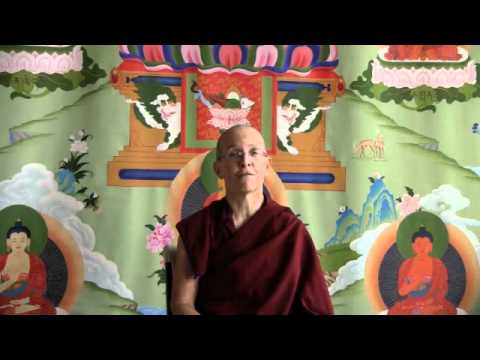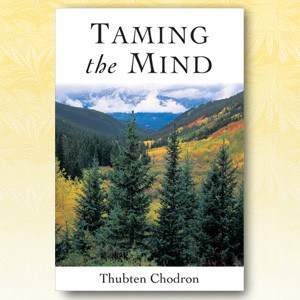The three characteristics
Venerable Thubten Semkye discusses the three characteristics of cyclic existence for a Bodhisattva's Breakfast Corner talk.
Venerable Jigme and I have been sharing the Dharma with the folks down at the Unitarian Universalist Church in Spokane, Washington on Monday nights. We’ve been going through some of the basic lamrim meditations on the nature of the mind and how the mind is a source of happiness and pain. We covered those two last week. Then we were thinking, “What can we share that will bring some more clarity to folks about where we get into trouble? Why do we think that something besides our minds is a source of happiness and pain?”
This past Monday I shared what we call the three characteristics of cyclic existence. These three describe our present situation here in samsara and how we get into trouble. Also, they describe how, by looking at our situation a little bit more realistically, we can see our potential for developing the kind of mind where we begin to understand that it is indeed the source of happiness and pain.
All phenomena is transient
The first of the three characteristics is that all this phenomena in our world is transient. It changes moment-by-moment; all phenomena are impermanent. Everything comes into existence due to causes and conditions and abides due to causes and conditions. When the causes and conditions for that phenomena (whatever it is) cease, so does the object or the experience.
If anyone is like me, you might think, “Of course, things are impermanent. I understand that. I look at outside and the leaves are changing. The seasons are changing. The food on my plate soon disappears. I understand impermanence, not a problem.” But then we check-in and think, “Well, what happens when something breaks, or a relationship ends, or you lose your job, or somebody dies?” We inevitably find ourselves extremely surprised at the level of emotion behind it. Although intellectually we say that we get impermanence, on the heart level, at least for me, I don’t truly get impermanence, and that is a major cause of my pain and discontent. That’s one of the first characteristics of cyclic existence.
Three kinds of duhkha
The second characteristic of phenomena is called unsatisfactoriness. This is broken down into three different types of what we call duhkha, a Pali word, which means unsatisfactory conditions. The three conditions are the unsatisfactoriness of having pain, the unsatisfactoriness of change, and the unsatisfactoriness of having what’s called “compounded unsatisfactoriness.” We can use duhkha in there just for an easier word to say than unsatisfactoriness.
The first type of dukkha is the dukkha of pain, which is that “Ouch!” kind of suffering. That’s the reality of samsara. It either comes in the form of physical things, like broken bones, or colds, or diseases, or it comes in the form of some kind of mental pain, like depression, or anxiety, fear, or anger. There are a lot of afflictive emotions.
The second type of duhkha is the duhkha of change, which is much more subtle than the duhkha of pain—the “Ouch!” kind of suffering. Every sentient being in the world probably gets the idea that there’s an “Ouch!” kind of suffering. The second one, which is more subtle than the suffering of pain, is what we call “happiness is not true happiness.”
The example that I gave the other night was of missing your lunch and coming home really hungry. The person that you live with or your housemate or someone has gifted you with a homemade lasagna. You sit down to eat and the first few bites are, I would say, real happiness. But, in fact, rather than happiness it is actually the diminishing of the big suffering, which is the suffering of hunger. And the beginnings of the suffering of eating are so small that we haven’t noticed yet, so we misunderstand it as a form of happiness.
But if we were to take logic and apply it to this experience, it would seem that the more lasagna we ate, the happier we would become. I think there was a general consensus in the room that night that most of us have had this direct experience since we know that is not true. Although we love to eat, generally speaking, we know that the more that we eat does not bring the experience of happiness. You can apply this to just about any type of experience, at least in human terms: walking, sitting, sleeping, having sex, being with friends. Any type of experiential action that we do will sooner or later become apparent that it is, by its very nature, suffering.
The third one is the compounded duhkha, or unsatisfactoriness. This is the most subtle one because we may not really think that the mind is under the control of karma and afflictions. And although we perceive sometimes that we’re happy and content, we don’t have a lot of control about how the happiness and contentment arise. It tends to get sabotaged, and thereby the distortions and the afflictions arise due to negative karma. Because we’re in cyclic existence, we misunderstand the nature of reality. We have got ourselves in the cycle of getting born, getting old, getting sick, and dying, and that is due to the ignorance that misunderstands these three characteristics of duhkha, among other things.
Selflessness of phenomena
The third characteristic of phenomena is the selflessness of phenomena. We have two little Dharma dogs that come to the class: Buster and Sophie. Sophie—who we all think is cute as a button and whom we believe exists from her own side completely—wears these little sweaters, and she has a little nose. She’s just so sweet. So, we began to separate her parts. We just started putting her nose over there, and her ears over there, and her tail over there, and her fur somewhere else. Where was Sophie? It was kind of an interesting experience because we just love Sophie, and we think that she exists as that little dog unto herself, and that there is this essence of Sophieness that exists within that little dog with the little sweater with the pumpkin on it. But she doesn’t exist like that. And because we do perceive she exists like that, if anything should ever happen to Sophie, it would just break our hearts.
This is also one of the misunderstandings. The truth of living in samsara is that all things are not findable under analysis. They don’t exist the way that they appear, but because we do think they exist the way that they appear, it can cause a lot of heartache.
The reason I think that Venerable Jigme and I chose this topic is because we have a lot of folks in this group, and we’ve been seeing this growing, wonderful thing with these people wanting to understand why they have these levels of discontent and restlessness and unhappiness in their lives. They want to understand, “Where am I? Where is my thinking going wrong? What tools can you give me that can help me get some clarity and to be able to bring some reality, some validity, to my life so I can look at things realistically, know what their flaws are and what their capacity is? How I can have a relationship to my life—the things and the objects in it—more realistically?”
Look at the three characteristics regarding how phenomena exist: everything is impermanent, everything is in the nature of unsatisfactoriness, and every object in this phenomenal world has no inherent existence from its own side. All things exist due to causes and conditions, by their parts—which are generally not the thing either—and by the mind that labels it.
We had a very enlightening conversation after that talk. People are doing a lot of thinking about how they can apply this to their lives so they don’t always feel like they are getting side-swiped by things and events. We find ourselves surprised by our strong emotions. But we offered it because we all want to understand things more realistically. It’s going to be a continuing, enlivening conversation, I think, as the week’s go on. So, hopefully this is helpful.
Venerable Thubten Semkye
Ven. Semkye was the Abbey's first lay resident, coming to help Venerable Chodron with the gardens and land management in the spring of 2004. She became the Abbey's third nun in 2007 and received bhikshuni ordination in Taiwan in 2010. She met Venerable Chodron at the Dharma Friendship Foundation in Seattle in 1996. She took refuge in 1999. When the land was acquired for the Abbey in 2003, Ven. Semye coordinated volunteers for the initial move-in and early remodeling. A founder of Friends of Sravasti Abbey, she accepted the position of chairperson to provide the Four Requisites for the monastic community. Realizing that was a difficult task to do from 350 miles away, she moved to the Abbey in spring of 2004. Although she didn't originally see ordination in her future, after the 2006 Chenrezig retreat when she spent half of her meditation time reflecting on death and impermanence, Ven. Semkye realized that ordaining would be the wisest, most compassionate use of her life. View pictures of her ordination. Ven. Semkye draws on her extensive experience in landscaping and horticulture to manage the Abbey's forests and gardens. She oversees "Offering Volunteer Service Weekends" during which volunteers help with construction, gardening, and forest stewardship.


